Comparison Between Legal System of USA, France & Germany
VerifiedAdded on 2022/08/31
|10
|2575
|28
AI Summary
Contribute Materials
Your contribution can guide someone’s learning journey. Share your
documents today.
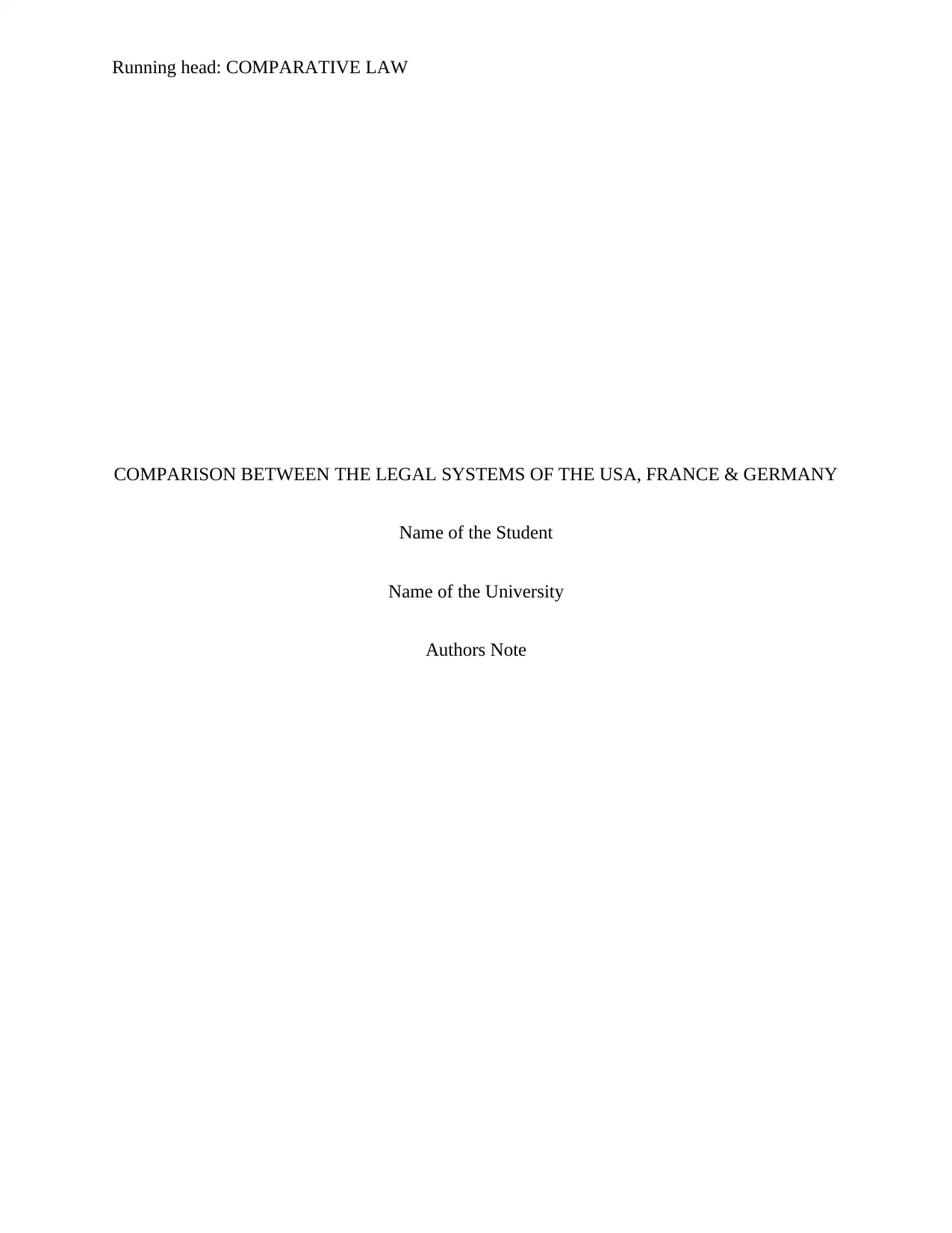
Running head: COMPARATIVE LAW
COMPARISON BETWEEN THE LEGAL SYSTEMS OF THE USA, FRANCE & GERMANY
Name of the Student
Name of the University
Authors Note
COMPARISON BETWEEN THE LEGAL SYSTEMS OF THE USA, FRANCE & GERMANY
Name of the Student
Name of the University
Authors Note
Secure Best Marks with AI Grader
Need help grading? Try our AI Grader for instant feedback on your assignments.
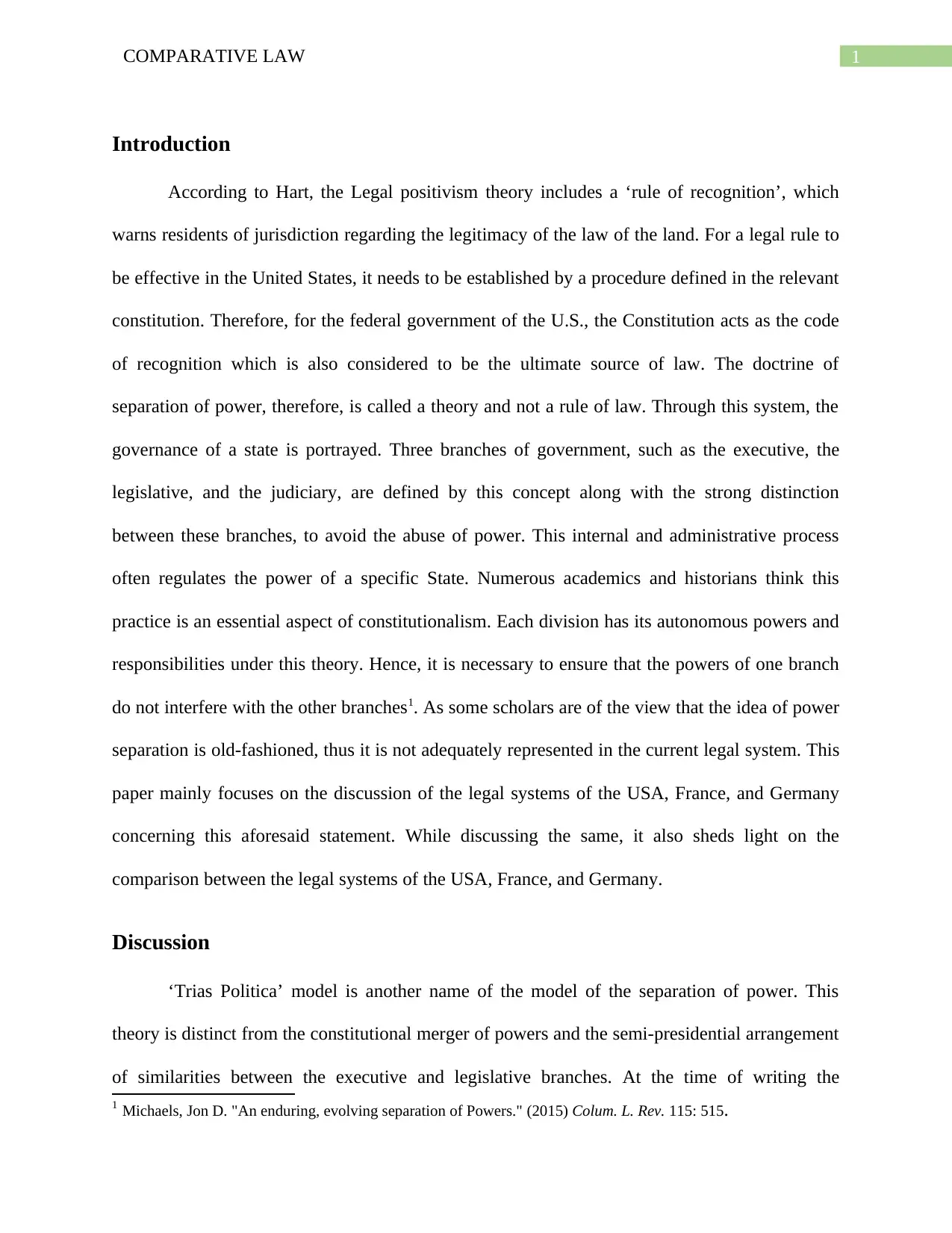
1COMPARATIVE LAW
Introduction
According to Hart, the Legal positivism theory includes a ‘rule of recognition’, which
warns residents of jurisdiction regarding the legitimacy of the law of the land. For a legal rule to
be effective in the United States, it needs to be established by a procedure defined in the relevant
constitution. Therefore, for the federal government of the U.S., the Constitution acts as the code
of recognition which is also considered to be the ultimate source of law. The doctrine of
separation of power, therefore, is called a theory and not a rule of law. Through this system, the
governance of a state is portrayed. Three branches of government, such as the executive, the
legislative, and the judiciary, are defined by this concept along with the strong distinction
between these branches, to avoid the abuse of power. This internal and administrative process
often regulates the power of a specific State. Numerous academics and historians think this
practice is an essential aspect of constitutionalism. Each division has its autonomous powers and
responsibilities under this theory. Hence, it is necessary to ensure that the powers of one branch
do not interfere with the other branches1. As some scholars are of the view that the idea of power
separation is old-fashioned, thus it is not adequately represented in the current legal system. This
paper mainly focuses on the discussion of the legal systems of the USA, France, and Germany
concerning this aforesaid statement. While discussing the same, it also sheds light on the
comparison between the legal systems of the USA, France, and Germany.
Discussion
‘Trias Politica’ model is another name of the model of the separation of power. This
theory is distinct from the constitutional merger of powers and the semi-presidential arrangement
of similarities between the executive and legislative branches. At the time of writing the
1 Michaels, Jon D. "An enduring, evolving separation of Powers." (2015) Colum. L. Rev. 115: 515.
Introduction
According to Hart, the Legal positivism theory includes a ‘rule of recognition’, which
warns residents of jurisdiction regarding the legitimacy of the law of the land. For a legal rule to
be effective in the United States, it needs to be established by a procedure defined in the relevant
constitution. Therefore, for the federal government of the U.S., the Constitution acts as the code
of recognition which is also considered to be the ultimate source of law. The doctrine of
separation of power, therefore, is called a theory and not a rule of law. Through this system, the
governance of a state is portrayed. Three branches of government, such as the executive, the
legislative, and the judiciary, are defined by this concept along with the strong distinction
between these branches, to avoid the abuse of power. This internal and administrative process
often regulates the power of a specific State. Numerous academics and historians think this
practice is an essential aspect of constitutionalism. Each division has its autonomous powers and
responsibilities under this theory. Hence, it is necessary to ensure that the powers of one branch
do not interfere with the other branches1. As some scholars are of the view that the idea of power
separation is old-fashioned, thus it is not adequately represented in the current legal system. This
paper mainly focuses on the discussion of the legal systems of the USA, France, and Germany
concerning this aforesaid statement. While discussing the same, it also sheds light on the
comparison between the legal systems of the USA, France, and Germany.
Discussion
‘Trias Politica’ model is another name of the model of the separation of power. This
theory is distinct from the constitutional merger of powers and the semi-presidential arrangement
of similarities between the executive and legislative branches. At the time of writing the
1 Michaels, Jon D. "An enduring, evolving separation of Powers." (2015) Colum. L. Rev. 115: 515.
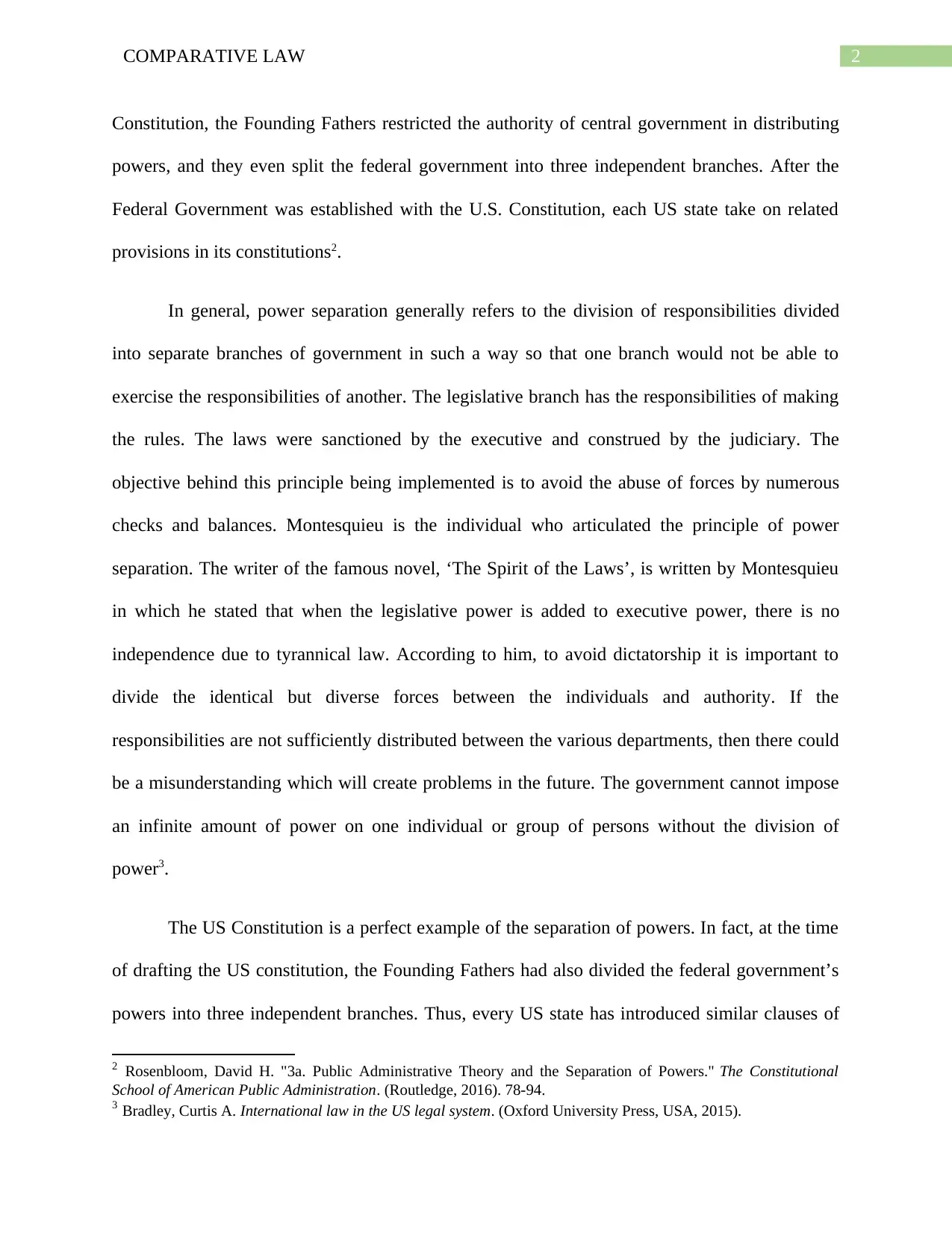
2COMPARATIVE LAW
Constitution, the Founding Fathers restricted the authority of central government in distributing
powers, and they even split the federal government into three independent branches. After the
Federal Government was established with the U.S. Constitution, each US state take on related
provisions in its constitutions2.
In general, power separation generally refers to the division of responsibilities divided
into separate branches of government in such a way so that one branch would not be able to
exercise the responsibilities of another. The legislative branch has the responsibilities of making
the rules. The laws were sanctioned by the executive and construed by the judiciary. The
objective behind this principle being implemented is to avoid the abuse of forces by numerous
checks and balances. Montesquieu is the individual who articulated the principle of power
separation. The writer of the famous novel, ‘The Spirit of the Laws’, is written by Montesquieu
in which he stated that when the legislative power is added to executive power, there is no
independence due to tyrannical law. According to him, to avoid dictatorship it is important to
divide the identical but diverse forces between the individuals and authority. If the
responsibilities are not sufficiently distributed between the various departments, then there could
be a misunderstanding which will create problems in the future. The government cannot impose
an infinite amount of power on one individual or group of persons without the division of
power3.
The US Constitution is a perfect example of the separation of powers. In fact, at the time
of drafting the US constitution, the Founding Fathers had also divided the federal government’s
powers into three independent branches. Thus, every US state has introduced similar clauses of
2 Rosenbloom, David H. "3a. Public Administrative Theory and the Separation of Powers." The Constitutional
School of American Public Administration. (Routledge, 2016). 78-94.
3 Bradley, Curtis A. International law in the US legal system. (Oxford University Press, USA, 2015).
Constitution, the Founding Fathers restricted the authority of central government in distributing
powers, and they even split the federal government into three independent branches. After the
Federal Government was established with the U.S. Constitution, each US state take on related
provisions in its constitutions2.
In general, power separation generally refers to the division of responsibilities divided
into separate branches of government in such a way so that one branch would not be able to
exercise the responsibilities of another. The legislative branch has the responsibilities of making
the rules. The laws were sanctioned by the executive and construed by the judiciary. The
objective behind this principle being implemented is to avoid the abuse of forces by numerous
checks and balances. Montesquieu is the individual who articulated the principle of power
separation. The writer of the famous novel, ‘The Spirit of the Laws’, is written by Montesquieu
in which he stated that when the legislative power is added to executive power, there is no
independence due to tyrannical law. According to him, to avoid dictatorship it is important to
divide the identical but diverse forces between the individuals and authority. If the
responsibilities are not sufficiently distributed between the various departments, then there could
be a misunderstanding which will create problems in the future. The government cannot impose
an infinite amount of power on one individual or group of persons without the division of
power3.
The US Constitution is a perfect example of the separation of powers. In fact, at the time
of drafting the US constitution, the Founding Fathers had also divided the federal government’s
powers into three independent branches. Thus, every US state has introduced similar clauses of
2 Rosenbloom, David H. "3a. Public Administrative Theory and the Separation of Powers." The Constitutional
School of American Public Administration. (Routledge, 2016). 78-94.
3 Bradley, Curtis A. International law in the US legal system. (Oxford University Press, USA, 2015).
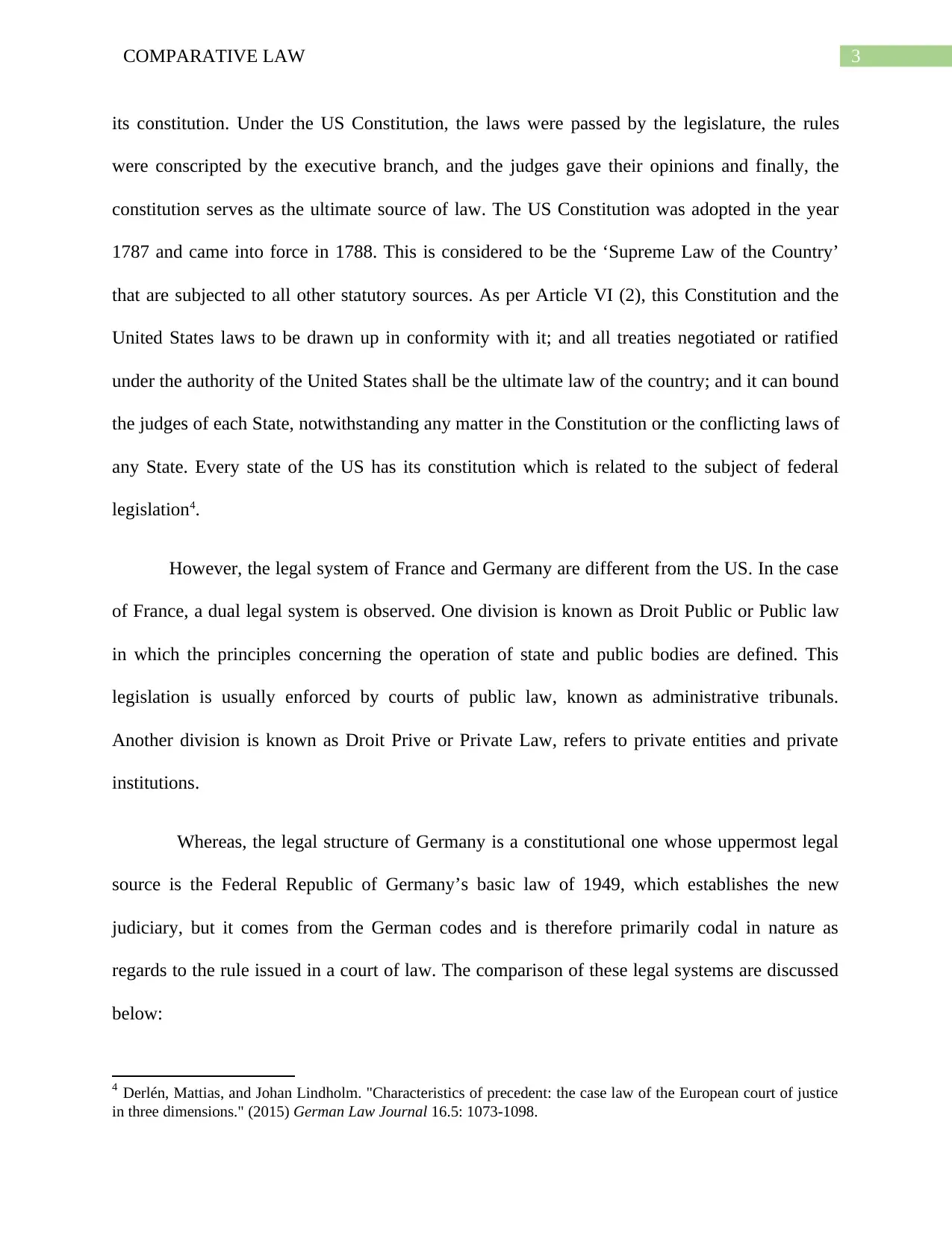
3COMPARATIVE LAW
its constitution. Under the US Constitution, the laws were passed by the legislature, the rules
were conscripted by the executive branch, and the judges gave their opinions and finally, the
constitution serves as the ultimate source of law. The US Constitution was adopted in the year
1787 and came into force in 1788. This is considered to be the ‘Supreme Law of the Country’
that are subjected to all other statutory sources. As per Article VI (2), this Constitution and the
United States laws to be drawn up in conformity with it; and all treaties negotiated or ratified
under the authority of the United States shall be the ultimate law of the country; and it can bound
the judges of each State, notwithstanding any matter in the Constitution or the conflicting laws of
any State. Every state of the US has its constitution which is related to the subject of federal
legislation4.
However, the legal system of France and Germany are different from the US. In the case
of France, a dual legal system is observed. One division is known as Droit Public or Public law
in which the principles concerning the operation of state and public bodies are defined. This
legislation is usually enforced by courts of public law, known as administrative tribunals.
Another division is known as Droit Prive or Private Law, refers to private entities and private
institutions.
Whereas, the legal structure of Germany is a constitutional one whose uppermost legal
source is the Federal Republic of Germany’s basic law of 1949, which establishes the new
judiciary, but it comes from the German codes and is therefore primarily codal in nature as
regards to the rule issued in a court of law. The comparison of these legal systems are discussed
below:
4 Derlén, Mattias, and Johan Lindholm. "Characteristics of precedent: the case law of the European court of justice
in three dimensions." (2015) German Law Journal 16.5: 1073-1098.
its constitution. Under the US Constitution, the laws were passed by the legislature, the rules
were conscripted by the executive branch, and the judges gave their opinions and finally, the
constitution serves as the ultimate source of law. The US Constitution was adopted in the year
1787 and came into force in 1788. This is considered to be the ‘Supreme Law of the Country’
that are subjected to all other statutory sources. As per Article VI (2), this Constitution and the
United States laws to be drawn up in conformity with it; and all treaties negotiated or ratified
under the authority of the United States shall be the ultimate law of the country; and it can bound
the judges of each State, notwithstanding any matter in the Constitution or the conflicting laws of
any State. Every state of the US has its constitution which is related to the subject of federal
legislation4.
However, the legal system of France and Germany are different from the US. In the case
of France, a dual legal system is observed. One division is known as Droit Public or Public law
in which the principles concerning the operation of state and public bodies are defined. This
legislation is usually enforced by courts of public law, known as administrative tribunals.
Another division is known as Droit Prive or Private Law, refers to private entities and private
institutions.
Whereas, the legal structure of Germany is a constitutional one whose uppermost legal
source is the Federal Republic of Germany’s basic law of 1949, which establishes the new
judiciary, but it comes from the German codes and is therefore primarily codal in nature as
regards to the rule issued in a court of law. The comparison of these legal systems are discussed
below:
4 Derlén, Mattias, and Johan Lindholm. "Characteristics of precedent: the case law of the European court of justice
in three dimensions." (2015) German Law Journal 16.5: 1073-1098.
Secure Best Marks with AI Grader
Need help grading? Try our AI Grader for instant feedback on your assignments.
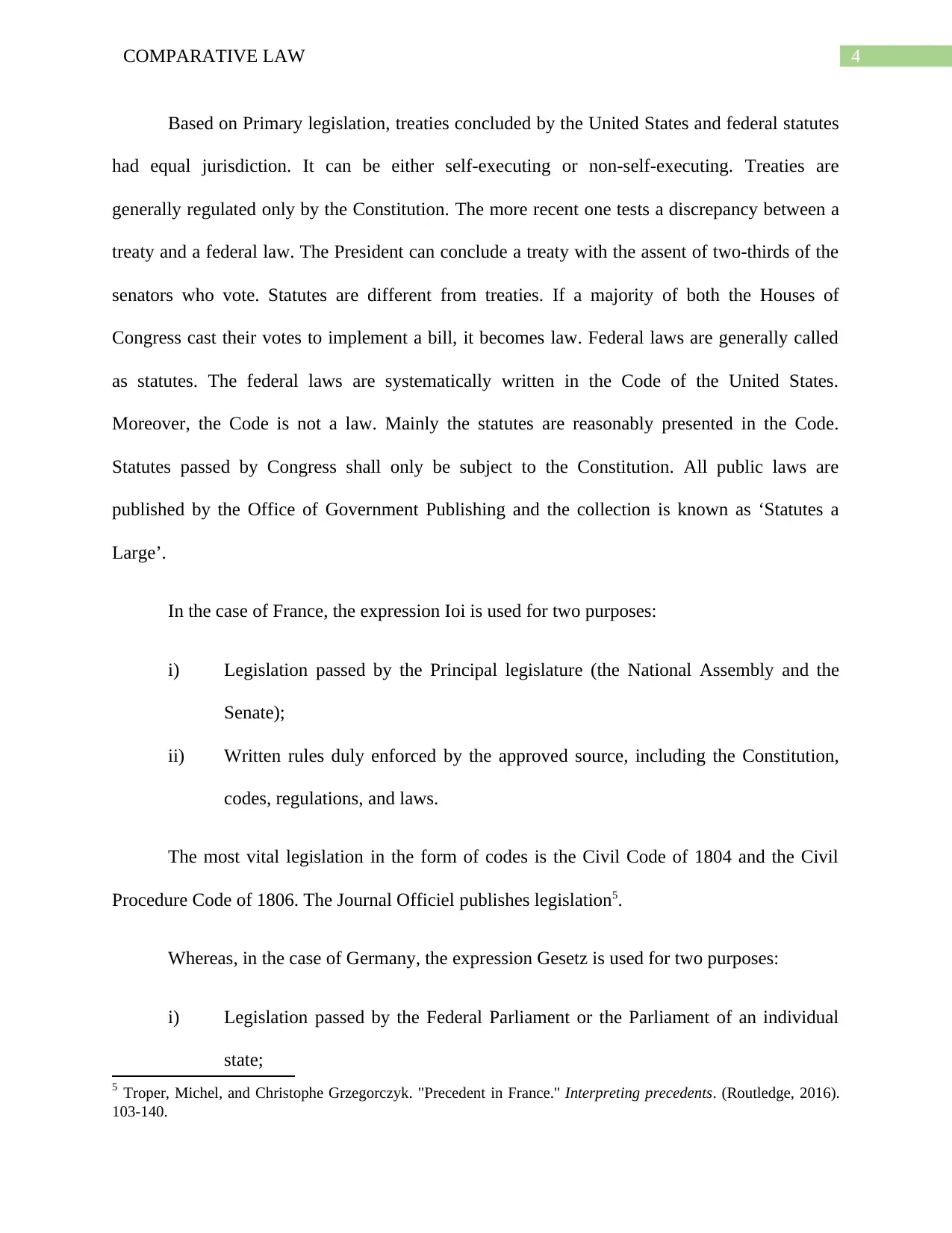
4COMPARATIVE LAW
Based on Primary legislation, treaties concluded by the United States and federal statutes
had equal jurisdiction. It can be either self-executing or non-self-executing. Treaties are
generally regulated only by the Constitution. The more recent one tests a discrepancy between a
treaty and a federal law. The President can conclude a treaty with the assent of two-thirds of the
senators who vote. Statutes are different from treaties. If a majority of both the Houses of
Congress cast their votes to implement a bill, it becomes law. Federal laws are generally called
as statutes. The federal laws are systematically written in the Code of the United States.
Moreover, the Code is not a law. Mainly the statutes are reasonably presented in the Code.
Statutes passed by Congress shall only be subject to the Constitution. All public laws are
published by the Office of Government Publishing and the collection is known as ‘Statutes a
Large’.
In the case of France, the expression Ioi is used for two purposes:
i) Legislation passed by the Principal legislature (the National Assembly and the
Senate);
ii) Written rules duly enforced by the approved source, including the Constitution,
codes, regulations, and laws.
The most vital legislation in the form of codes is the Civil Code of 1804 and the Civil
Procedure Code of 1806. The Journal Officiel publishes legislation5.
Whereas, in the case of Germany, the expression Gesetz is used for two purposes:
i) Legislation passed by the Federal Parliament or the Parliament of an individual
state;
5 Troper, Michel, and Christophe Grzegorczyk. "Precedent in France." Interpreting precedents. (Routledge, 2016).
103-140.
Based on Primary legislation, treaties concluded by the United States and federal statutes
had equal jurisdiction. It can be either self-executing or non-self-executing. Treaties are
generally regulated only by the Constitution. The more recent one tests a discrepancy between a
treaty and a federal law. The President can conclude a treaty with the assent of two-thirds of the
senators who vote. Statutes are different from treaties. If a majority of both the Houses of
Congress cast their votes to implement a bill, it becomes law. Federal laws are generally called
as statutes. The federal laws are systematically written in the Code of the United States.
Moreover, the Code is not a law. Mainly the statutes are reasonably presented in the Code.
Statutes passed by Congress shall only be subject to the Constitution. All public laws are
published by the Office of Government Publishing and the collection is known as ‘Statutes a
Large’.
In the case of France, the expression Ioi is used for two purposes:
i) Legislation passed by the Principal legislature (the National Assembly and the
Senate);
ii) Written rules duly enforced by the approved source, including the Constitution,
codes, regulations, and laws.
The most vital legislation in the form of codes is the Civil Code of 1804 and the Civil
Procedure Code of 1806. The Journal Officiel publishes legislation5.
Whereas, in the case of Germany, the expression Gesetz is used for two purposes:
i) Legislation passed by the Federal Parliament or the Parliament of an individual
state;
5 Troper, Michel, and Christophe Grzegorczyk. "Precedent in France." Interpreting precedents. (Routledge, 2016).
103-140.
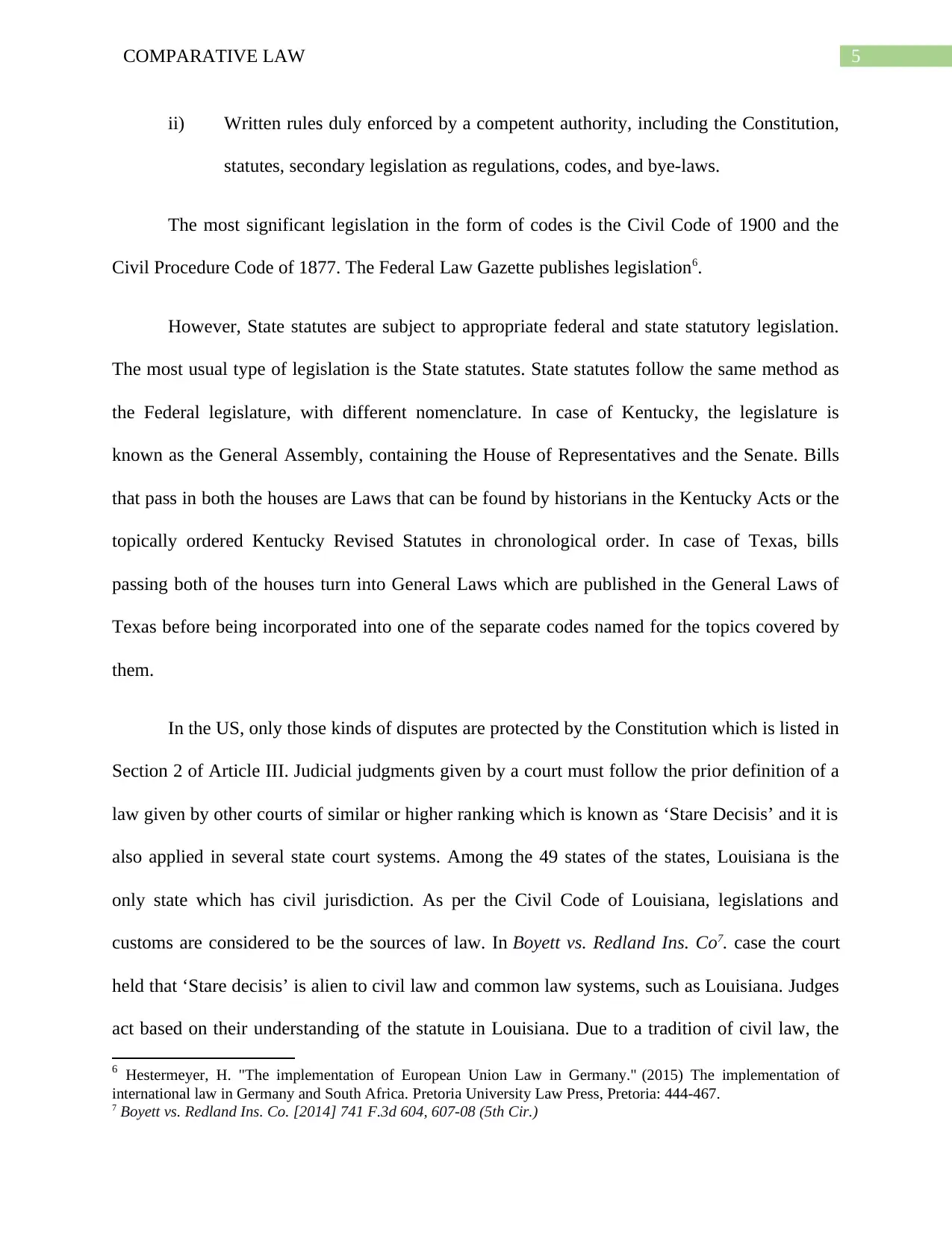
5COMPARATIVE LAW
ii) Written rules duly enforced by a competent authority, including the Constitution,
statutes, secondary legislation as regulations, codes, and bye-laws.
The most significant legislation in the form of codes is the Civil Code of 1900 and the
Civil Procedure Code of 1877. The Federal Law Gazette publishes legislation6.
However, State statutes are subject to appropriate federal and state statutory legislation.
The most usual type of legislation is the State statutes. State statutes follow the same method as
the Federal legislature, with different nomenclature. In case of Kentucky, the legislature is
known as the General Assembly, containing the House of Representatives and the Senate. Bills
that pass in both the houses are Laws that can be found by historians in the Kentucky Acts or the
topically ordered Kentucky Revised Statutes in chronological order. In case of Texas, bills
passing both of the houses turn into General Laws which are published in the General Laws of
Texas before being incorporated into one of the separate codes named for the topics covered by
them.
In the US, only those kinds of disputes are protected by the Constitution which is listed in
Section 2 of Article III. Judicial judgments given by a court must follow the prior definition of a
law given by other courts of similar or higher ranking which is known as ‘Stare Decisis’ and it is
also applied in several state court systems. Among the 49 states of the states, Louisiana is the
only state which has civil jurisdiction. As per the Civil Code of Louisiana, legislations and
customs are considered to be the sources of law. In Boyett vs. Redland Ins. Co7. case the court
held that ‘Stare decisis’ is alien to civil law and common law systems, such as Louisiana. Judges
act based on their understanding of the statute in Louisiana. Due to a tradition of civil law, the
6 Hestermeyer, H. "The implementation of European Union Law in Germany." (2015) The implementation of
international law in Germany and South Africa. Pretoria University Law Press, Pretoria: 444-467.
7 Boyett vs. Redland Ins. Co. [2014] 741 F.3d 604, 607-08 (5th Cir.)
ii) Written rules duly enforced by a competent authority, including the Constitution,
statutes, secondary legislation as regulations, codes, and bye-laws.
The most significant legislation in the form of codes is the Civil Code of 1900 and the
Civil Procedure Code of 1877. The Federal Law Gazette publishes legislation6.
However, State statutes are subject to appropriate federal and state statutory legislation.
The most usual type of legislation is the State statutes. State statutes follow the same method as
the Federal legislature, with different nomenclature. In case of Kentucky, the legislature is
known as the General Assembly, containing the House of Representatives and the Senate. Bills
that pass in both the houses are Laws that can be found by historians in the Kentucky Acts or the
topically ordered Kentucky Revised Statutes in chronological order. In case of Texas, bills
passing both of the houses turn into General Laws which are published in the General Laws of
Texas before being incorporated into one of the separate codes named for the topics covered by
them.
In the US, only those kinds of disputes are protected by the Constitution which is listed in
Section 2 of Article III. Judicial judgments given by a court must follow the prior definition of a
law given by other courts of similar or higher ranking which is known as ‘Stare Decisis’ and it is
also applied in several state court systems. Among the 49 states of the states, Louisiana is the
only state which has civil jurisdiction. As per the Civil Code of Louisiana, legislations and
customs are considered to be the sources of law. In Boyett vs. Redland Ins. Co7. case the court
held that ‘Stare decisis’ is alien to civil law and common law systems, such as Louisiana. Judges
act based on their understanding of the statute in Louisiana. Due to a tradition of civil law, the
6 Hestermeyer, H. "The implementation of European Union Law in Germany." (2015) The implementation of
international law in Germany and South Africa. Pretoria University Law Press, Pretoria: 444-467.
7 Boyett vs. Redland Ins. Co. [2014] 741 F.3d 604, 607-08 (5th Cir.)
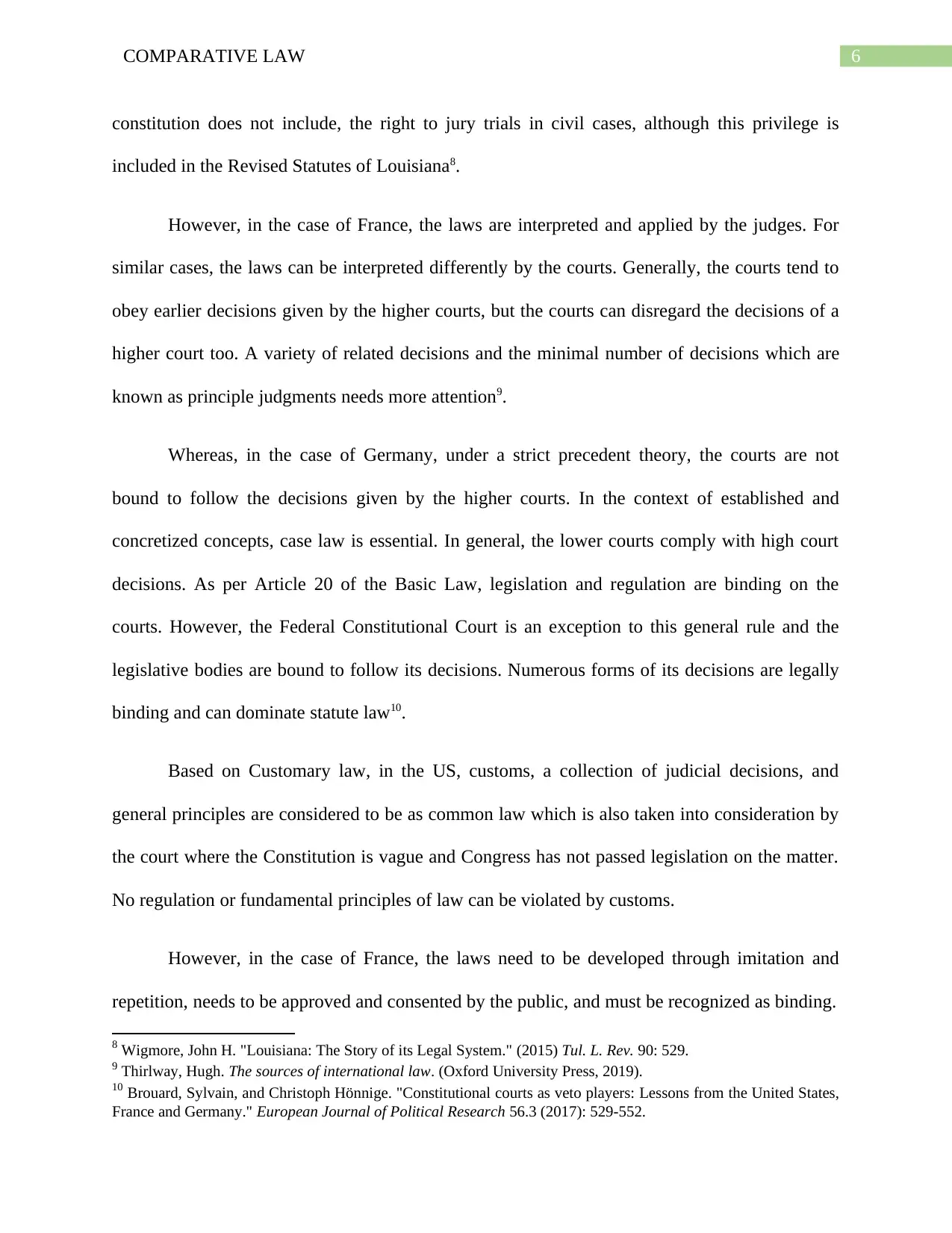
6COMPARATIVE LAW
constitution does not include, the right to jury trials in civil cases, although this privilege is
included in the Revised Statutes of Louisiana8.
However, in the case of France, the laws are interpreted and applied by the judges. For
similar cases, the laws can be interpreted differently by the courts. Generally, the courts tend to
obey earlier decisions given by the higher courts, but the courts can disregard the decisions of a
higher court too. A variety of related decisions and the minimal number of decisions which are
known as principle judgments needs more attention9.
Whereas, in the case of Germany, under a strict precedent theory, the courts are not
bound to follow the decisions given by the higher courts. In the context of established and
concretized concepts, case law is essential. In general, the lower courts comply with high court
decisions. As per Article 20 of the Basic Law, legislation and regulation are binding on the
courts. However, the Federal Constitutional Court is an exception to this general rule and the
legislative bodies are bound to follow its decisions. Numerous forms of its decisions are legally
binding and can dominate statute law10.
Based on Customary law, in the US, customs, a collection of judicial decisions, and
general principles are considered to be as common law which is also taken into consideration by
the court where the Constitution is vague and Congress has not passed legislation on the matter.
No regulation or fundamental principles of law can be violated by customs.
However, in the case of France, the laws need to be developed through imitation and
repetition, needs to be approved and consented by the public, and must be recognized as binding.
8 Wigmore, John H. "Louisiana: The Story of its Legal System." (2015) Tul. L. Rev. 90: 529.
9 Thirlway, Hugh. The sources of international law. (Oxford University Press, 2019).
10 Brouard, Sylvain, and Christoph Hönnige. "Constitutional courts as veto players: Lessons from the United States,
France and Germany." European Journal of Political Research 56.3 (2017): 529-552.
constitution does not include, the right to jury trials in civil cases, although this privilege is
included in the Revised Statutes of Louisiana8.
However, in the case of France, the laws are interpreted and applied by the judges. For
similar cases, the laws can be interpreted differently by the courts. Generally, the courts tend to
obey earlier decisions given by the higher courts, but the courts can disregard the decisions of a
higher court too. A variety of related decisions and the minimal number of decisions which are
known as principle judgments needs more attention9.
Whereas, in the case of Germany, under a strict precedent theory, the courts are not
bound to follow the decisions given by the higher courts. In the context of established and
concretized concepts, case law is essential. In general, the lower courts comply with high court
decisions. As per Article 20 of the Basic Law, legislation and regulation are binding on the
courts. However, the Federal Constitutional Court is an exception to this general rule and the
legislative bodies are bound to follow its decisions. Numerous forms of its decisions are legally
binding and can dominate statute law10.
Based on Customary law, in the US, customs, a collection of judicial decisions, and
general principles are considered to be as common law which is also taken into consideration by
the court where the Constitution is vague and Congress has not passed legislation on the matter.
No regulation or fundamental principles of law can be violated by customs.
However, in the case of France, the laws need to be developed through imitation and
repetition, needs to be approved and consented by the public, and must be recognized as binding.
8 Wigmore, John H. "Louisiana: The Story of its Legal System." (2015) Tul. L. Rev. 90: 529.
9 Thirlway, Hugh. The sources of international law. (Oxford University Press, 2019).
10 Brouard, Sylvain, and Christoph Hönnige. "Constitutional courts as veto players: Lessons from the United States,
France and Germany." European Journal of Political Research 56.3 (2017): 529-552.
Paraphrase This Document
Need a fresh take? Get an instant paraphrase of this document with our AI Paraphraser
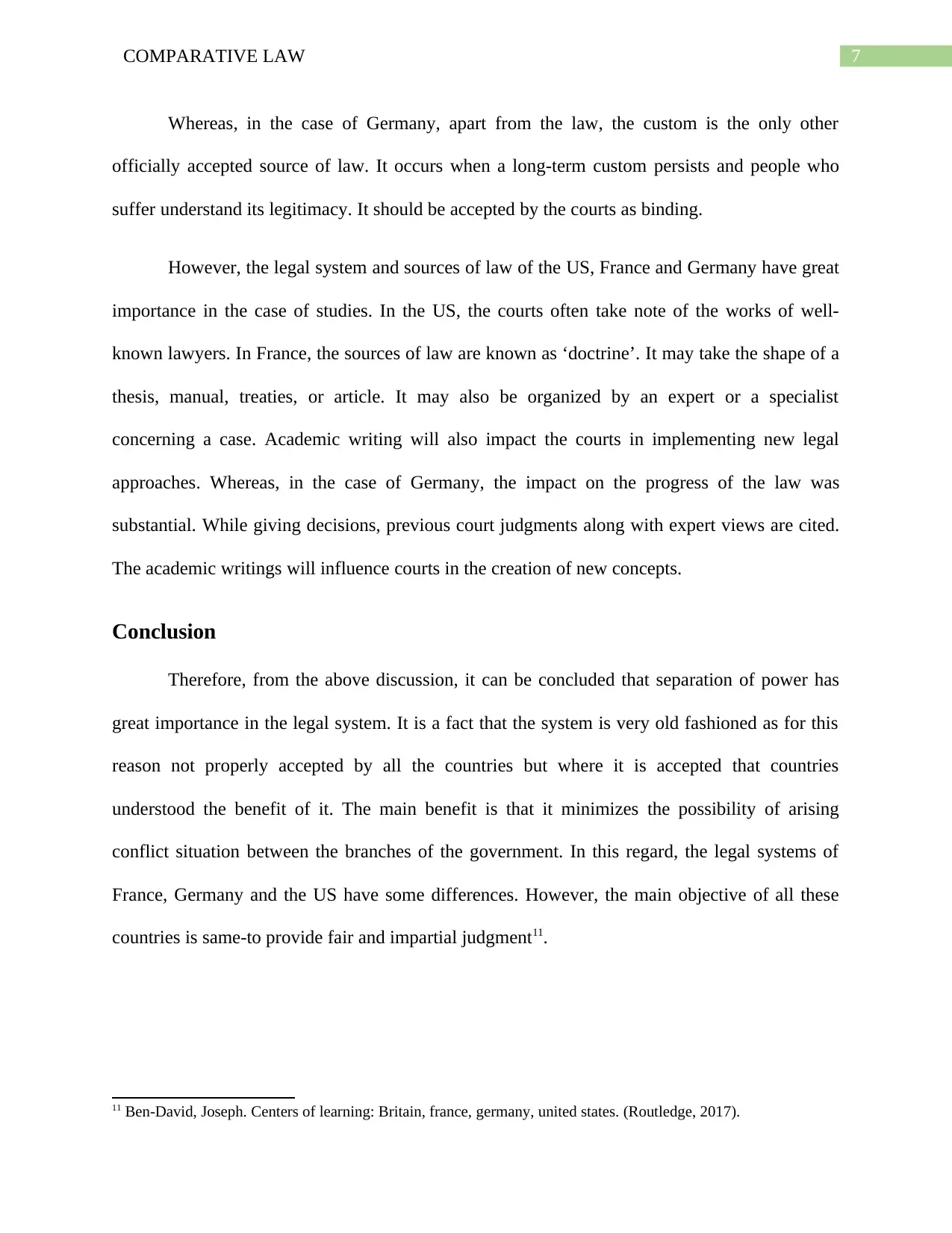
7COMPARATIVE LAW
Whereas, in the case of Germany, apart from the law, the custom is the only other
officially accepted source of law. It occurs when a long-term custom persists and people who
suffer understand its legitimacy. It should be accepted by the courts as binding.
However, the legal system and sources of law of the US, France and Germany have great
importance in the case of studies. In the US, the courts often take note of the works of well-
known lawyers. In France, the sources of law are known as ‘doctrine’. It may take the shape of a
thesis, manual, treaties, or article. It may also be organized by an expert or a specialist
concerning a case. Academic writing will also impact the courts in implementing new legal
approaches. Whereas, in the case of Germany, the impact on the progress of the law was
substantial. While giving decisions, previous court judgments along with expert views are cited.
The academic writings will influence courts in the creation of new concepts.
Conclusion
Therefore, from the above discussion, it can be concluded that separation of power has
great importance in the legal system. It is a fact that the system is very old fashioned as for this
reason not properly accepted by all the countries but where it is accepted that countries
understood the benefit of it. The main benefit is that it minimizes the possibility of arising
conflict situation between the branches of the government. In this regard, the legal systems of
France, Germany and the US have some differences. However, the main objective of all these
countries is same-to provide fair and impartial judgment11.
11 Ben-David, Joseph. Centers of learning: Britain, france, germany, united states. (Routledge, 2017).
Whereas, in the case of Germany, apart from the law, the custom is the only other
officially accepted source of law. It occurs when a long-term custom persists and people who
suffer understand its legitimacy. It should be accepted by the courts as binding.
However, the legal system and sources of law of the US, France and Germany have great
importance in the case of studies. In the US, the courts often take note of the works of well-
known lawyers. In France, the sources of law are known as ‘doctrine’. It may take the shape of a
thesis, manual, treaties, or article. It may also be organized by an expert or a specialist
concerning a case. Academic writing will also impact the courts in implementing new legal
approaches. Whereas, in the case of Germany, the impact on the progress of the law was
substantial. While giving decisions, previous court judgments along with expert views are cited.
The academic writings will influence courts in the creation of new concepts.
Conclusion
Therefore, from the above discussion, it can be concluded that separation of power has
great importance in the legal system. It is a fact that the system is very old fashioned as for this
reason not properly accepted by all the countries but where it is accepted that countries
understood the benefit of it. The main benefit is that it minimizes the possibility of arising
conflict situation between the branches of the government. In this regard, the legal systems of
France, Germany and the US have some differences. However, the main objective of all these
countries is same-to provide fair and impartial judgment11.
11 Ben-David, Joseph. Centers of learning: Britain, france, germany, united states. (Routledge, 2017).
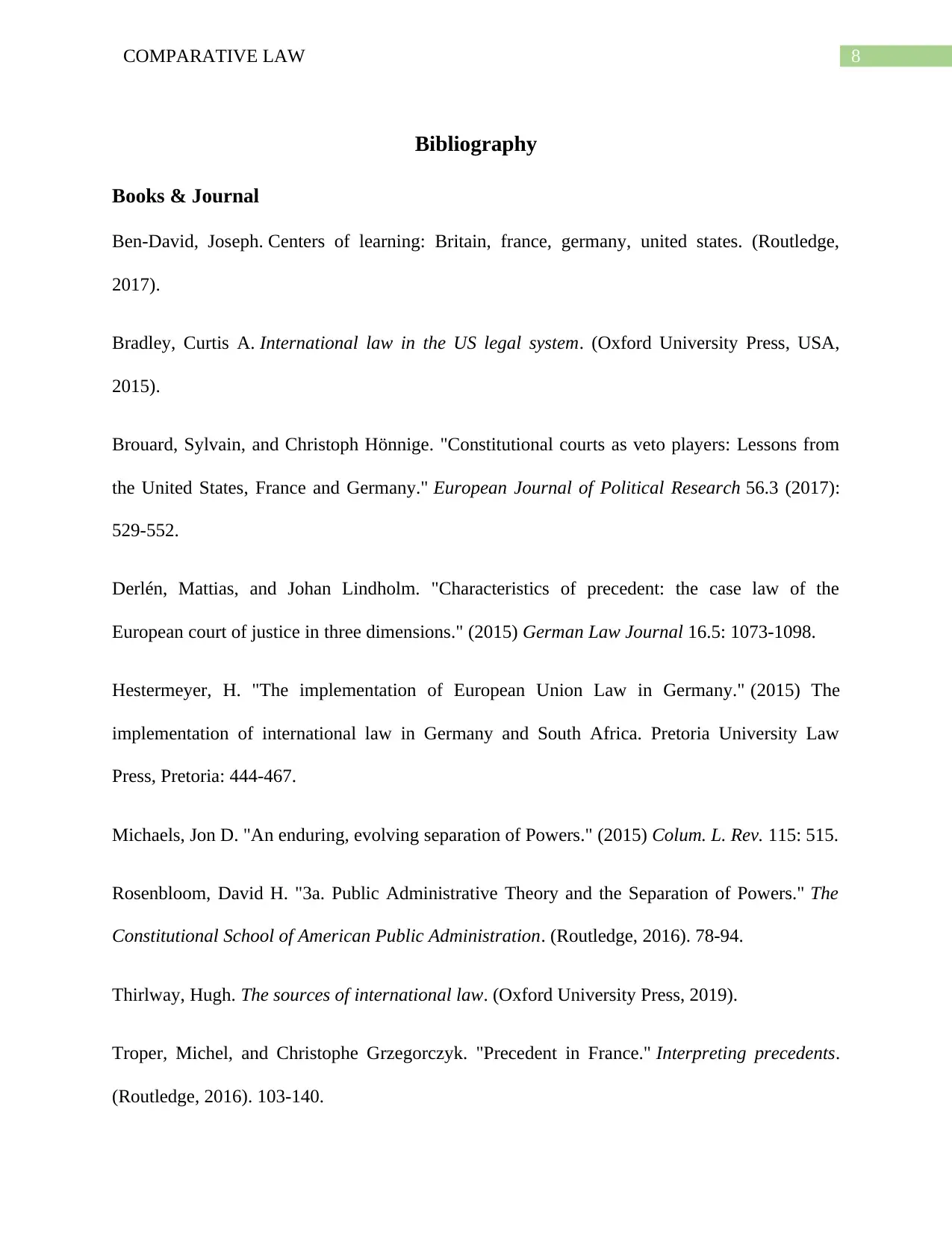
8COMPARATIVE LAW
Bibliography
Books & Journal
Ben-David, Joseph. Centers of learning: Britain, france, germany, united states. (Routledge,
2017).
Bradley, Curtis A. International law in the US legal system. (Oxford University Press, USA,
2015).
Brouard, Sylvain, and Christoph Hönnige. "Constitutional courts as veto players: Lessons from
the United States, France and Germany." European Journal of Political Research 56.3 (2017):
529-552.
Derlén, Mattias, and Johan Lindholm. "Characteristics of precedent: the case law of the
European court of justice in three dimensions." (2015) German Law Journal 16.5: 1073-1098.
Hestermeyer, H. "The implementation of European Union Law in Germany." (2015) The
implementation of international law in Germany and South Africa. Pretoria University Law
Press, Pretoria: 444-467.
Michaels, Jon D. "An enduring, evolving separation of Powers." (2015) Colum. L. Rev. 115: 515.
Rosenbloom, David H. "3a. Public Administrative Theory and the Separation of Powers." The
Constitutional School of American Public Administration. (Routledge, 2016). 78-94.
Thirlway, Hugh. The sources of international law. (Oxford University Press, 2019).
Troper, Michel, and Christophe Grzegorczyk. "Precedent in France." Interpreting precedents.
(Routledge, 2016). 103-140.
Bibliography
Books & Journal
Ben-David, Joseph. Centers of learning: Britain, france, germany, united states. (Routledge,
2017).
Bradley, Curtis A. International law in the US legal system. (Oxford University Press, USA,
2015).
Brouard, Sylvain, and Christoph Hönnige. "Constitutional courts as veto players: Lessons from
the United States, France and Germany." European Journal of Political Research 56.3 (2017):
529-552.
Derlén, Mattias, and Johan Lindholm. "Characteristics of precedent: the case law of the
European court of justice in three dimensions." (2015) German Law Journal 16.5: 1073-1098.
Hestermeyer, H. "The implementation of European Union Law in Germany." (2015) The
implementation of international law in Germany and South Africa. Pretoria University Law
Press, Pretoria: 444-467.
Michaels, Jon D. "An enduring, evolving separation of Powers." (2015) Colum. L. Rev. 115: 515.
Rosenbloom, David H. "3a. Public Administrative Theory and the Separation of Powers." The
Constitutional School of American Public Administration. (Routledge, 2016). 78-94.
Thirlway, Hugh. The sources of international law. (Oxford University Press, 2019).
Troper, Michel, and Christophe Grzegorczyk. "Precedent in France." Interpreting precedents.
(Routledge, 2016). 103-140.

9COMPARATIVE LAW
Wigmore, John H. "Louisiana: The Story of its Legal System." (2015) Tul. L. Rev. 90: 529.
Cases
Boyett vs. Redland Ins. Co. [2014] 741 F.3d 604, 607-08 (5th Cir.)
Wigmore, John H. "Louisiana: The Story of its Legal System." (2015) Tul. L. Rev. 90: 529.
Cases
Boyett vs. Redland Ins. Co. [2014] 741 F.3d 604, 607-08 (5th Cir.)
1 out of 10
Related Documents
Your All-in-One AI-Powered Toolkit for Academic Success.
+13062052269
info@desklib.com
Available 24*7 on WhatsApp / Email
![[object Object]](/_next/static/media/star-bottom.7253800d.svg)
Unlock your academic potential
© 2024 | Zucol Services PVT LTD | All rights reserved.





